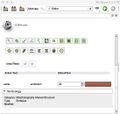Difference between revisions of "2016 Summer Project Week/Segmentation Editor and Terminology"
From NAMIC Wiki
| Line 21: | Line 21: | ||
<!-- Approach and Plan bullet points --> | <!-- Approach and Plan bullet points --> | ||
* The initial plan was for the Segment Editor to incoporate the display of terminology, ported from the Editor module. The next stage is to add support for editing the terminologies and adding new ones. | * The initial plan was for the Segment Editor to incoporate the display of terminology, ported from the Editor module. The next stage is to add support for editing the terminologies and adding new ones. | ||
| − | * Review overview sildes [https://www.slicer.org/slicerWiki/index.php/File:20160526_Segmentations.pptx | + | * Review overview sildes [https://www.slicer.org/slicerWiki/index.php/File:20160526_Segmentations.pptx Segmentations] |
| − | * Source code review: [https://subversion.assembla.com/svn/slicerrt/trunk/SlicerRt/src/ | + | * Source code review: [https://subversion.assembla.com/svn/slicerrt/trunk/SlicerRt/src/ SlicerRT] ([https://github.com/SlicerRt/SlicerRT/ github mirror]), with a focus on containers (vtkSegment, vtkSegmentation, vtkMRMLSegmentationNode), and widget GUI (Segmentations Widgets qMRMLSegmentsTableView) |
* Compare to web app for populating SEG metadata: http://qiicr.org/dcmq | * Compare to web app for populating SEG metadata: http://qiicr.org/dcmq | ||
* From Andrey: disconnect segment ID from the color ID and from the terminology associated with it - it should be possible to have more than one distinctive segment that has the same color and the same terminology, but are differentiated by segment ID and segment label. | * From Andrey: disconnect segment ID from the color ID and from the terminology associated with it - it should be possible to have more than one distinctive segment that has the same color and the same terminology, but are differentiated by segment ID and segment label. | ||
Revision as of 12:26, 22 June 2016
Home < 2016 Summer Project Week < Segmentation Editor and TerminologyKey Investigators
- Nicole Aucoin (BWH)
- Csaba Pinter (Queens)
- Andrey Fedorov (BWH)
| Objective | Approach and Plan | Progress and Next Steps |
|---|---|---|
|
|
|
Use cases
- Category = Segmented Property Category
- Type = Segmented Property Type (+Modifier, optional)
- Anatomic region (+Modifier, optional)
Loading segmentation from DICOM
Assumptions:
- can expect that Category and Type will be initialized, if not - fall back to default codes (Tissue/Tissue codes)
- anatomic region may or may not be initialized (example: can specify anatomic location of the tumor, but may not be present)
- colors may or may not be specified
Consequences:
- need to be able to handle these various combinations
- if colors are not specified, would be nice to suggest some good default color choices (to optimize differentiation of the structures? lookup of default colors may not be easy for medium-large dictionaries)
- it is not clear that it is a good idea to restrict the choices of terminology (or colors) if a user wants to modify segmentation loaded from DICOM - so it might be helpful to choose from existing color maps / terminology dictionaries for a DICOM-loaded segmentation
Creating segmentation from scratch
- choose from predefined dictionaries (combinations of Type/Category/Anatomy customized for a specific use case)
- choose from predefined color tables, or perhaps color assignment strategies (e.g., high contrast, similar shades of color for the segments corresponding to the same kind of structure)
Workflow
To add a new segment:
- user clicks "add segment"
- terminology and color are populated to some default value
- user has an option to change the color and terminology separately TerminologyWidget (naming to be confirmed)
- user has the option to choose the dictionary in the TerminologyWidget
- the purpose of the dictionary is to define specific combinations of category/type/anatomy for the specific use case (GenericAnatomy LUT is one example, and we will also need a larger set of codes defined by the standard)

